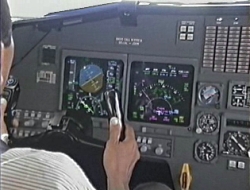FAR 135.227:
a) No pilot may take off an aircraft that has frost, snow, or ice adhering to any rotor blade, propeller, windshield, wing, stabilizing or control surface, to a powerplant installation, or to an airspeed, altimeter, rate of climb, or flight attitude instrument system, except under the following conditions:
(1) Takeoffs may be made with frost adhering to the wings, or stabilizing or control surfaces, if the frost has been polished to make it smooth.
(2) Takeoffs may be made with frost under the wing in the area of the fuel tanks if authorized by the administrator.
U.S. air safety regulators have decided, after almost 50 years, that it's no longer safe for private and cargo aircraft to fly with "polished frost'' on their wings.
Frozen Contaminants and their Causes
Federal Aviation Administration
14 CFR Parts 91, 125 and 135
SUMMARY: The FAA is removing certain provisions in its regulations that allow for operations with "polished frost'' (i.e., frost polished to make it smooth) on the wings and stabilizing and control surfaces of aircraft. The rule is expected to increase safety by not allowing operations with ``polished frost,'' which the FAA has determined increases the risk of unsafe flight.
DATES: These amendments become effective February 1, 2010.
There are at least 12 \1\ known accidents in which individuals attempted to smooth or polish frost, but the aircraft failed to generate enough lift and crashed shortly after takeoff.\2\ The U.S.
National Transportation Safety Board (NTSB) has urged operators to ensure that critical surfaces are free of contamination prior to take off.
The FAA has determined that an unsafe condition exists if all wing surfaces, other than those under the wing in the area of the fuel tanks,\3\ and other critical surfaces are not uniformly smooth upon takeoff and is therefore removing references to ``polished frost'' from the regulations. This final rule requires operators, when performing operations under part 91 subpart F, part 125, or part 135, to remove all frost from critical surfaces in order to achieve uncontaminated surface smoothness.
In the NPRM, the FAA identified four alternatives to polishing frost that operators may use to comply with this rule. Those alternatives are: (1) Using wing covers to prevent frost accumulation on wings, (2) waiting for frost to melt, (3) storing the aircraft in a heated hangar, or (4) deicing the wing surface. The FAA identified the use of wing covers to prevent frost accumulation on wing surfaces as the lowest-cost alternative for complying with this rule.
Summary of the Final Rule
This final rule removes language from part 91 subpart F, and parts 125 and 135, which permits aircraft to takeoff with frost that has been polished to make it smooth (``polished frost'') on critical surfaces.
Under the final rule, operators will be required to remove any frost adhering to critical surfaces prior to takeoff. Additionally, the rule restructures language in parts 91, 125, and 135 to clarify that aircraft must have functioning deicing or anti-icing equipment to fly under IFR into known or forecast light or moderate icing conditions, or under VFR into known light or moderate icing conditions.
Ice, snow, and frost are frozen contaminants, and they can form and accumulate on exterior aircraft surfaces on the ground. Weather causes this accumulation as do ground operational conditions conducive to icing. In either case, atmospheric conditions vary the type of accumulation, the amount, etc. Generally, icing conditions (during flight or ground operations) occur and ice protection systems or procedures should be activated when the outside air temperature (OAT) is below 50_F (10_C) and visible moisture is present or when there is standing water, ice, or snow on runways or taxiways.
Aircraft in flight experience a variety of atmospheric conditions which alone or together
can produce ice formations on the aircraft and its components. These conditions include:
- Supercooled clouds.
These droplets are very small (five to 100 microns), and they freeze on impact with another object. Water droplets have remained liquid even at temperatures as low as -40F.
The areas requiring special attention during a cold-weather preflight depend on the aircraft's design. FAR Part 135 and 125 certificate holders will identify these areas in the training program they are required to develop. Borrowing from what's required for that training program, general aviation pilots should pay particular attention to:
Wing leading edges, upper and lower surfaces
Vertical and horizontal stabilizing devices, leading edges, upper surfaces, lower surfaces, and side panels
Lift/drag devices (e.g., flaps)
Spoilers and speed brakes
All control surfaces and control balance bays
Propellers, spinners
Engine inlets, particle separators, and screens
Windshields and other windows necessary for visibility
Antennas
Fuselage
Exposed instrumentation devices, e.g., angle-of-attack vanes, pitot-static pressure probes, static ports
- Fuel tanks and fuel cap vents
Landing gear If you know or suspect that the aircraft has been subjected to blowing snow, check any openings where snow can enter and freeze. In addition to and including the above, check:
Pitot tubes and static system sensing ports
Wheel wells/wheel pants
Heater intakes
Engine air intakes and carburetor intakes
Elevator and rudder controls
Fuel vents











Nenhum comentário:
Postar um comentário